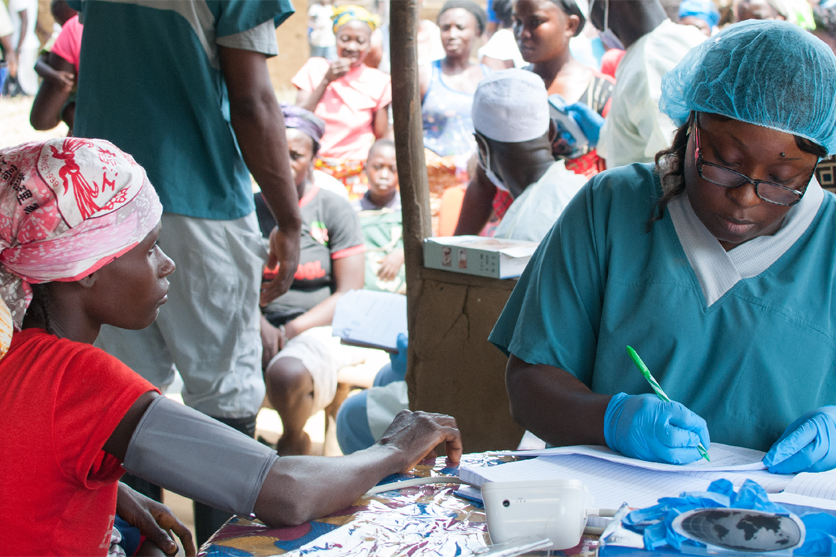Strengthening Emergency Response through SBCC: The Importance of Preparedness
Emergency preparedness is a prerequisite for rapid and effective response during a crisis. Preparedness activities are designed to reduce vulnerability and strengthen resilience, mitigating potential human, material and economic losses. The Nepal earthquake, the Ebola Virus Disease (EVD) outbreak in the Mano River region and Zika outbreaks across the Americas and the Pacific have all demonstrated that public health emergencies require both immediate humanitarian action and longer term development planning. Social and behavior change communication (SBCC) bridges humanitarian and development efforts by creating sustainable yet responsive systems. These systems facilitate the adoption of protective behaviors leading to immediate and long-term positive health outcomes.
 Within the broad category of emergency preparedness activities, the primary focus of the Health Communication Capacity Collaborative (HC3) is to strengthen health and communication systems through SBCC. HC3 currently works on various phases of emergency response in Cote d’Ivoire, Dominican Republic, El Salvador, Guatemala, Guinea-Bissau, Guinea Conakry, Honduras, Liberia, Nepal and Sierra Leone. Through SBCC, HC3 is improving the capacity of national authorities and civil society to develop and implement measures for successful communication, coordination and crisis management for public health emergencies.
Within the broad category of emergency preparedness activities, the primary focus of the Health Communication Capacity Collaborative (HC3) is to strengthen health and communication systems through SBCC. HC3 currently works on various phases of emergency response in Cote d’Ivoire, Dominican Republic, El Salvador, Guatemala, Guinea-Bissau, Guinea Conakry, Honduras, Liberia, Nepal and Sierra Leone. Through SBCC, HC3 is improving the capacity of national authorities and civil society to develop and implement measures for successful communication, coordination and crisis management for public health emergencies.
On September 29, HC3 hosted the Strengthening Emergency Response through Social and Behavior Change Communication webinar to facilitate conversation around the ways leading humanitarian and development partners are using SBCC for emergencies. Moderator Amrita Gill-Bailey, Johns Hopkins Center for Communication Programs (CCP) Team Lead for Emergency Preparedness, opened the webinar with an overview of HC3’s activities, tools and resources related to emergency preparedness. Through its country programs, HC3 works to ensure that communication is integrated into the overall national emergency response mechanism and that SBCC activities are coordinated effectively at the national and community level. For example, in Guinea-Bissau, HC3 is supporting the National Institute of Public Health (INASA) on development of a health communication policy and strategy that looks at ways to adjust existing infrastructure to accommodate emergencies. HC3’s work in Cote d’Ivoire builds the capacity of media partners in risk and crisis communication to ensure the delivery of accurate health messages. HC3’s new SBCC for Emergency Preparedness Implementation Kit, a comprehensive resource complete with worksheets and exercises, provides a set of key considerations for SBCC activities in emergency situations.
Following Ms. Gill-Bailey, Mohamed Jalloh, epidemiologist at the Centers for Disease Control and Prevention (CDC) in the Division of Global Health Prevention, shared insights gathered from the multiple EVD Knowledge, Attitude, and Practices (KAP) surveys in Sierra Leone. The first case of EVD in Sierra Leone was detected in May 2014 and at the time, little was known about the disease in the local context. Lessons learned from cholera outbreaks were important in helping to design initial response interventions, but KAP data was needed to answer fundamental questions about the course of the outbreak. Without these data, interventions could not successfully address the behavioral drivers of the epidemic. The KAP research was used to inform the National Communication Strategy and National Messaging Guide, identify supply-side gaps and develop community-led activities. From the initial KAP study to the fourth one conducted 11 months later, misconceptions regarding EVD declined, behavioral intentions to seek medical care improved and attitudes toward safe burials improved – strongly suggesting that changes in behavior contributed to ending the EVD epidemic in Sierra Leone.
Every year, UNICEF responds to more than 250 emergencies, providing evidence-based SBCC through technical support to government and civil society organizations, research and rapid assessments, and social mobilization coordination. Dr. Rafael Obregon, Chief of Communication for UNICEF’s Development Section, spoke about the critical need to reorient humanitarian efforts away from simply trying to meet the immediate needs associated with emergencies, towards reducing the structural deficiencies that prolong crises. UNICEF believes that humanitarian and development partners must join together to identify and operationalize strategies that orient humanitarian response toward increased community engagement, resilience building and sustainability. By leading reform efforts to strengthen the development humanitarian nexus, UNICEF and its partners are working to ensure that country actors have adequate and predictable capacity to respond to emergencies at the soonest possible moment. Toward this effort, UNICEF is now working with partners such CDAC network, IFRC, OCHA, WHO to establish a communication and community engagement platform that aligns with the cluster approach.
While Dr. Obregon discussed restructuring the global humanitarian architecture, Dr. Alfonso Rosales – Maternal and Child Health Senior Technical Advisor, LACRO region Zika Response Director, World Vision US –discussed the need to focus on communities during outbreak response. Currently, World Vision operates in 12 Zika-affected countries and is preparing comprehensive prevention and awareness programs. To inform programming, KAP studies were conducted in Brazil, Colombia, Dominican Republic, Guatemala, Honduras and El Salvador. The studies found that knowledge of Zika virus transmission routes other than mosquito bites is low, knowledge of symptoms and signs of Zika infection is low, and protective practices against Zika virus are low. When concluding his presentation Dr. Rosales stated, “We will never control vector-borne outbreaks if we only focus on vector control; we need to focus on population-based preventive behaviors, and for this reason we need to make our communities active participants and not only recipients,” reiterating the important role of community-driven SBCC in outbreak prevention.
The SBCC approach to emergencies focuses on preparing for and responding to public health emergencies by building resilience at both the health system and community levels. Therefore, integrating SBCC into emergency preparedness, response and recovery planning helps to reduce the underlying risks that make communities vulnerable to public health emergencies. As highlighted during this webinar, institutionalization of SBCC into emergency planning will help to create the conditions under which future emergencies avoid unfolding into long-term development losses.
Join HC3 for this Upcoming, In-Person Event
Please install the The Events Calendar or The Events Calendar Pro Plugin to display a list of upcoming Events











Leave a Reply
Want to join the discussion?Feel free to contribute!